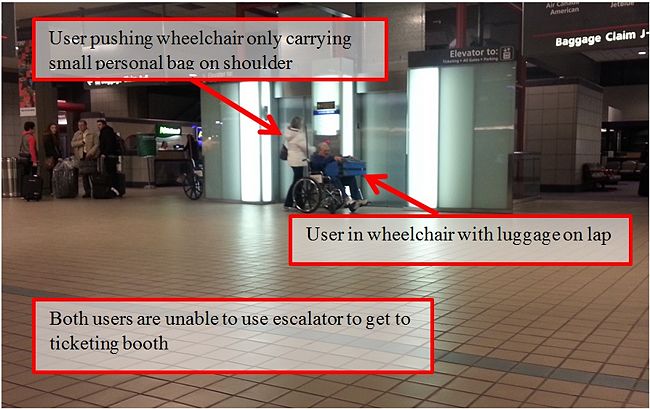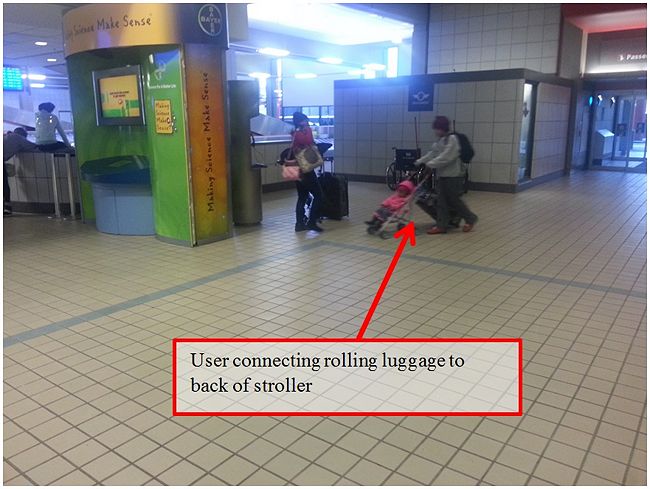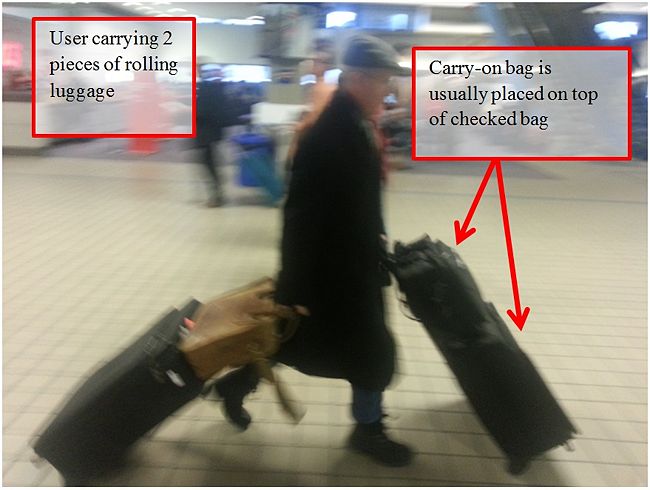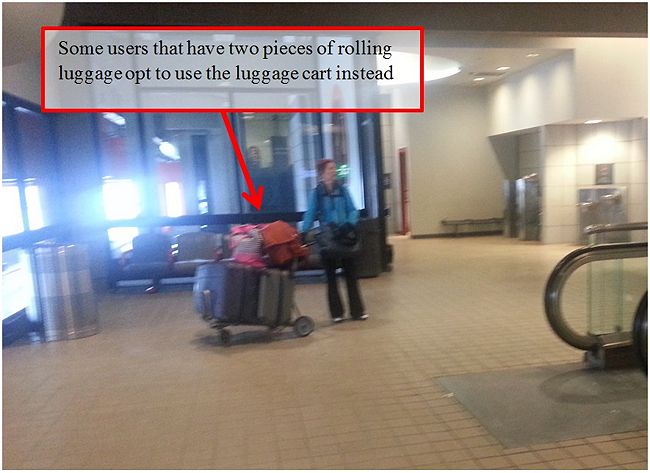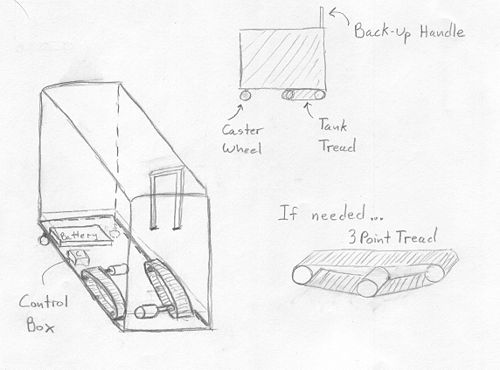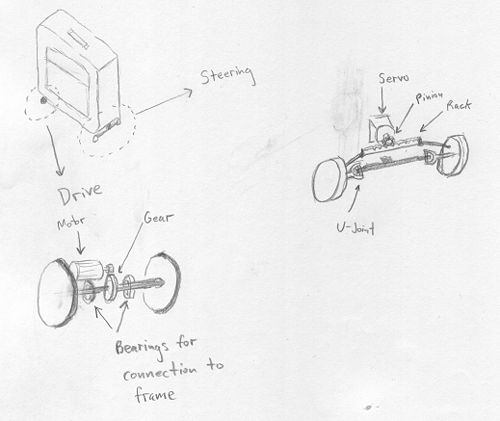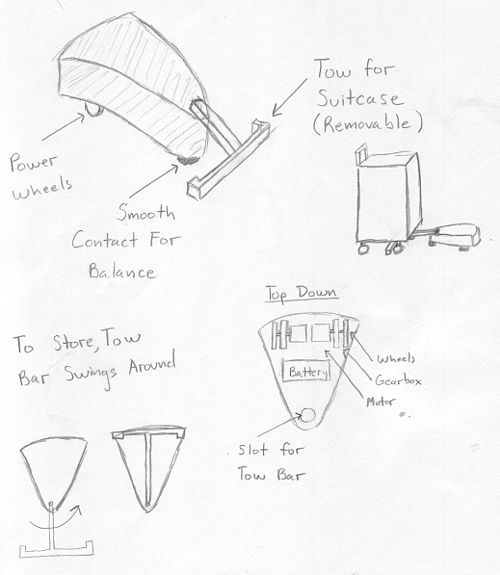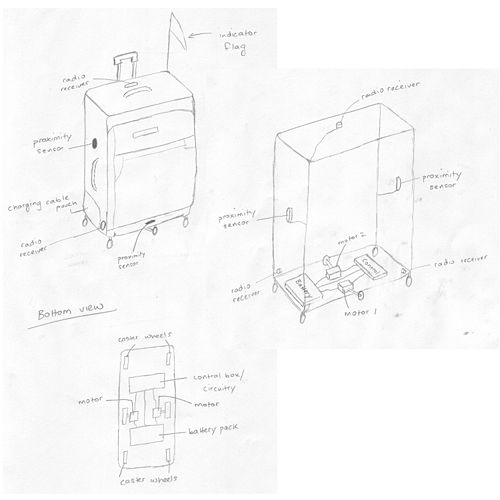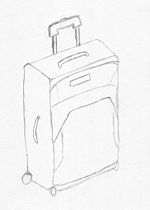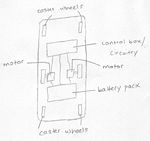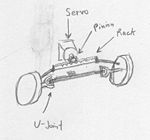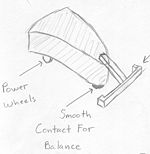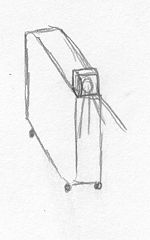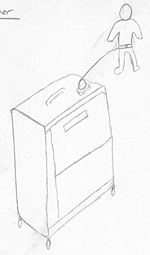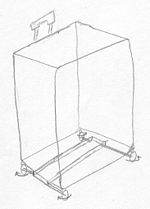Self-driving luggage opportunity
From DDL Wiki
Contents |
Exectutive Summary
The original intent of this opportunity study was to explore the personal goods transport market. While investigating this market at the Pittsburgh International Airport, we noticed that air travel often involves a multitude of suitcases, children, and miscellaneous personal effects. Carrying these items proved challenging for many individuals, particularly the elderly, disabled, and those with young children. These observations sparked the idea of creating a way of transporting luggage that reduced user effort compared to traditional luggage.
Our luggage requires two primary subsystems: the drivetrain and control scheme. In order to assist the consumer, all of our improved luggage ideas involve an electric drive system which requires a battery pack, electric motors, and a power distribution system. The control system requires sensors to interpret user inputs and a microcontroller to orchestrate luggage motion.
Given that our primary objective is to make travel easier, we our design concept comparisons show that a hands-free system best suits consumer needs. Hands-free control schemes range from visual tracking of the user to a physical tether connecting the user to the luggage. Drive systems considered include a trailer-like tow system, tank treads, and additional powered wheels in parallel with the existing wheels on traditional luggage. Using weighted comparison tools, we were able to determine that radio frequency triangulation and a center wheel drive setup would suit consumers’ needs best.
Market Research
Anthropological Observation
To learn more about how users interacted with their luggage, members of our team spent time at Pittsburgh International Airport. Observations were taken in areas of the airport with high foot traffic such as the entrance from the parking lot and the carrousel for retrieving checked-in bags.
One of our main focuses for our observations was users that had more than a single bag to carry around. These included users that were carrying multiple large checked bags, users carrying children in strollers, and handicapped users in wheelchairs. A common theme in these scenarios is that both users’ hands are being used and doing other tasks in the airport such as using a cell phone or checking boarding pass information can be tedious.
In addition to documenting users, our team also spoke with the representatives at the airline counters and the skycaps at the curb. An interesting point that they made was that users of airlines that allow more than one free checked bag generally split the maximum weight of a single bag into two bags. They also advised that baggage handling can be rough and anything hanging off the chassis of the luggage has potential to damage the bag.
Product Reviews
When users buy luggage through an online source, like Amazon.com, they are given the opportunity to rate and review their purchased luggage so that other potential buyers have a better idea of how that product performs. By analyzing these reviews we are able to identify several concerns that many buyers focus on. Maneuverability, stability, durability, and weight are at the top of this list. Maneuverability on flat, smooth surfaces is best achieved through the 4-wheel luggage that can by easily pushed next to the user. Vanessa Y from Madison, Wisconsin confirms, "I prefer four wheels. It's so much easier to wheel on flat surfaces ... and uses a LOT less strength" [3]. However, there is a general consensus that 2-wheel luggage offers superior control on rough surfaces where the 4-wheel luggage often gets stuck. Both 4-wheel and 2-wheel suitcases have stability issues when left standing freely. 4-wheel luggage usually rolls away too easily and 2-wheel luggage often tips over. The reviews regarding durability are largely separated into two categories - zipper/canvas strength and wheels. Most reviews about the zipper/canvas durability are based on the appearance of the luggage materials, while the majority of reviews on wheels are only created once a wheel brakes. The weight of the luggage also appears to be very important to the company because of increasing airline fees - flyers are trying to pack fewer bags and utilize all of the weight limit they are offered.
Many other reviews mentioned the importance of a handle on the bottom of the suitcase for easy loading/unloading from a car. While most positive reviews mentioned how smooth a suitcase was, negative reviews didn't complain about luggage ride quality until a wheel broke. These reviews were mainly focused on standard luggage - motorized luggage had very limited reviews. However, the ones available were largely negative. For example, Bloomberg Businessweek outlined Hops!'s limited space, poor balance and weight as objectives the suitcase does not deliver. [4].
User Surveys
In order to glean information on user interaction with luggage, a survey was conducted through two methods: the first through a post on Reddit’s r/samplesize and the second through a post on Amazon’s Mechanical Turk. Free response questions allowed the subjects to elaborate on their concerns and desires for travel with luggage.
Consumers of all ages were extremely anxious about keeping track of their belongings. Not only are they carrying their suitcases through the airport, they must deal with additional items like coats and purses. Keeping certain objects at hand (e.g. tickets, water bottles, IDs) is very stressful as they traverse the airport. This stress is increased when they go through security, as they must deal with preparing to go through scanners while keeping an eye on all of their belongings. Some airports will have the passenger go through security with their check-in luggage, further compounding the number of items they must keep track of. Furthermore, picking up their checked luggage poses the same issue. Dealing with luggage, handbags, carry-ons, etc., while using a phone exacerbates the issue. Forgetting an essential item such as a coat or a purse would cause many problems for the traveler. In cold weather, the passenger must carry and keep track of extra items such as a coat in addition to their typical travel accessories.
This shows that consumers like to feel as if they have control over their suitcases and belongings. Many are afraid to let them go, stating that they like to keep in physical contact with their bags. They are constantly worried about their possessions getting stolen or lost. This makes typical airport activities like getting food or going to the bathroom difficult, especially when one is traveling alone since they must keep hands on all of their belongings while performing these activities. Awkwardly shaped items make this all the more difficult. Of note are musicians traveling with their instruments and people with pets. Extra care must be given to these items, so they become even more cumbersome.
Lost luggage is another sore spot for passengers. It creates a big hassle for them, especially when they are away from home. Users of all ages would like a tracking system in their luggage. They suggest many forms, particularly apps that they can use with their phones. Some would like simple GPS tracking so their luggage can be found if lost, and others would like notification that their bag made it on their plane. Still others like the idea of an RFID tag so that lost bags can easily be identified and returned to their proper owners. Along the lines of passengers knowing where their bags are comes the notion that they would like to be alerted when their bags are coming off the collection belt so they don’t have to constantly look for it.
Another main issue lies with how their luggage gets handled; many are worried about the durability of the wheels and fabric/casing of the luggage. Since luggage may be handled roughly, even the hard-shelled suitcases may break. Consumers note issues with wheels breaking. Not only are they concerned about their luggage breaking, they are concerned with its contents breaking. Some people travel with gifts, wine, and other breakable items that can easily get damaged or broken. Along with how roughly luggage is handled, they are worried about security. Many comment on how they dislike how TSA must go through their belongings. Some report outcomes of messy contents or stolen items. Integrated locks and internal compartments were mentioned as possible solutions to issues with TSA. This may also help with other privacy issues mentioned. Some users do not like opening up their bags and having the contents exposed to the people around them. Not only does this lead to a lack of privacy, but it leads to messing up what can be carefully organized contents. Many people comment that they’d like less costly luggage in addition to fulfilling these changes.
Although many people report that their bags are typically under 50 pounds (the general weight limit for domestic flights in America), they are extremely worried about weight limits. Some mention that they’d like a built-in scale so that they can easily check the weight of their bag. Not only are they worried about the weight restrictions put on them by airlines, but they are also concerned with having to carry around heavy bags. Older consumers report that carrying around heavy bags becomes painful after a while, and tired arms are bothersome. Others report that it is annoying to have to carry around hefty carry-ons while on a layover. Carry-ons can become quite heavy as people are trying to stay under the allotted weight limits for their checked bags. This also creates issues with people trying to juggle a heavy bag and personal belongings.
In particular, bags can be a hassle with kids or with the elderly. They find moving around luggage is awkward and hard to maneuver. One participant suggested that handles should be made higher for taller people, so they don’t have to stoop to carry their luggage. Extrapolating from this, luggage should be more fitted to the consumer so it is less difficult for them to get through the airport. People with disabilities mentioned that they find it hard to manage multiple bags, and that it is frustrating for them to constantly ask for help. They call for luggage that they can manage themselves.
Secondary Research
As part of our market research study, we were also able to collect a secondary research study ([5]) that examined existing trolley suitcases and highlighted key advantages and disadvantage of current designs. The study, conducted by Adhikarla Saket Kashyap, a Masters student at the Indian Institute of Technology Delhi, was conducted to design a trolley suitcase for elderly passengers considering problems of maneuverability, handling and ease of transportation. The comprehensive project found existing inefficiencies through anthropological observations at roads, railway stations and airports, and numerous user interviews throughout India. Key findings are reported below.
2-wheeled Luggage
- Effort is required to pull the 2-wheeled luggage as the weight does not get transferred to the wheels and instead is transferred to the arms, back and shoulders.
- Pulling 2-wheeled suitcases often requires uncomfortable twisting motions (especially on uneven ground) adding additional strain on the user’s back.
- 2-wheeled luggage often bumps into the user’s legs when being pulled and requires the user to lift the suitcase with a bent posture when climbing stairs.
4-wheeled Luggage
- Much more convenient to use as each wheel can rotate 360-degrees thus enhancing maneuverability.
- Handling and turning on different surfaces is much easier compared to the 2-wheeled design as it requires a pushing motion rather than pulling.
- Using escalators and other obstacles is much easier especially if the other arm is occupied with another task.
- The 4-wheeled suitcase is harder to balance especially if one of the wheels is out of balance. This can cause the luggage to topple requiring additional effort from the user.
- The added maneuverability is a disadvantage when navigating slopes and uneven surfaces (such as roads, carpets, etc.) and leads to additional strain on the wrist and arm.
Duffel Bags
- Much easier to carry around and more space efficient than the 2 previous designs.
- Cannot be placed upright and therefore required greater effort from the user when stationary and moving.
- When encountering crowds and staircases, switching from the telescopic handles to the hand carry handles can sometimes be complicated.
- Uneven roads cause additional strain on the arm, shoulder and wrist since the bag needs to be pulled and the weight of the luggage is not centered on the wheels.
From these key findings, we can see that there is definitely an opportunity for improvement in all the current luggage designs. From the three suitcases analyzed, the 4-wheeled suitcase seems to be the most ergonomic design currently in mass production and could be a good candidate to improve further for this project.
Primary Stakeholders and Product Needs
Distributor Needs
Distributors are concerned with the ease and safety of transport.
- Packed to minimize material use
- Packed with the smallest box possible to save space
- Packed in boxes that stack efficiently
- Packed robustly enough to withstand bumps and slight drops
- Batteries must be shipped according to U.S. Department of Transportation
Retailer
Retailers have the same needs as distributors for stocking purposes, plus some needs unique to the seller of the product.
- Product is aesthetically pleasing to entice customers (e.g. a wide variety of colors/patterns)
- Large products are packaged in a way that is easy for a consumer to pick up and place in a cart or carry
Consumer
Luggage products are aimed at consumers who travel primarily through flying.
- Lightweight
- Easy to maneuver
- Secure belongings
- Robust
- Aesthetic/easily distinguishable
- Minimal effort to use
- Durable
- Protects belongings from damage
- Efficiently packs/organizes belongings
Market Opportunities
Top Ideas
After completing market research our team determined that an opportunity to make luggage control less stressful exists. Currently, travelers struggle in the attempt to simultaneously push their luggage, use their phones and hold other items (e.g. laptop bags, coats, bags). Travelers with children face even more hardships as they try to direct their children and carry their children's luggage as well as their own. A solution to this problem is to make pushing luggage the least of the user's issues, giving the users more opportunity to focus on their other tasks. Our top ideas utilized motorized luggage to make luggage transport easier, and they are separated into two categories - power systems and control schemes. The following sketches outline the different power drive systems we've considered most useful. Our main focus is to pick a drive system that is efficient, small, low-power and easy to manipulate after batteries lose their charge.
Tank treads can be driven and steered with only two motors. To steer, one set of treads must rotate faster than the other side, causing the luggage to steer in the direction of the slower tread. While great for rocky and uneven terrain, tread drives make travel on any terrain difficult when batteries run out and the user has to push the luggage manually.
Similar to a car's power train and steering system, luggage could have a motorized axle and a rack and pinion steering system to turn. This steering method is proven and well-understood, but could be less robust than other systems. The steering system would need complex gearing and universal joints that might brake easily.
Instead of integrating a drive system directly into the luggage, a tow-platform can separately pull luggage through the airport. However, this system will be heavier than any integrating drive, and users would have to exert effort attaching and disengaging luggage.
The center-drive system sketched above integrates an extra two-wheels and two-motors into existing luggage design. This integrated design allows greater optimization than a separate drive system (fifth wheel) and retains most of the maneuverability of standard luggage.
Any of the drive systems above will need a control scheme to effectively steer and drive the luggage. The control system that simply aids the user pushing his/her luggage is call motor-assist. Pressure pads on the handle of the luggage sense how much force users are exerting to accelerate the luggage, and the drive wheels apply proportional force to help accelerate the suitcase. While this system removes the physical stress related to carrying luggage, it does not remove the stress due to multi-tasking. In order to allow users to carry their bags, use their phones and direct their children, the luggage system must be hands-free and independent. To be truly hands-free, the luggage must follow the user through visual tracking, radio triangulation or a tether system. The visual system requires a lot of computing power and is subject to lighting conditions and blurred video capture. The radio triangulation could be inaccurate or prone to interference. The tether systems could cause hazards to nearby travelers who walk into the line. In any case, we propose a system that alerts the user when luggage is a certain distance away from them to avoid lost or stolen luggage.
Competitor Products
There are a large range of 2-wheel and 4-wheel suitcases in the luggage market. However, motorized luggage searches only result in two products: the discontinued Live Luggage Suitcase and Hop! which is still in development. Live-Luggage is a suitcase system "which feels as light as a feather, powers up when it senses gradients and curbs and takes all the weight and effort out of pulling."[6]. Through an innovative handle and powered wheels, it can help make travel through the airport effortless for 1.5 miles. Afterwards, it can be pulled like a regular 2-wheel suitcase. However, it remains heavy (about 23lb) and requires the user to hold the suitcase's handle. Hop! is a new autonomous suitcase that utilizes Bluetooth to triangulate the user's position and drive towards it on two tank treads [7]. However, the suitcase is small and unstable, and if the battery runs out unexpectedly there is no handle for ordinary manual control.
There are numerous patents describing various forms of motorized luggage. Common examples include modifying existing luggage with a simple manual motor control scheme [8] and luggage/vehicle hybrids which allow the consumer to ride their luggage instead of walking [9]. Interestingly, the aforementioned Hop! luggage system is not patented, allowing us to implement a similar wireless control scheme. More generally, no patents on fully hands-free luggage appear to have been filed with the USPTO.
![Picture of Live-Luggage taken from [1]](/ddl/images/thumb/Liveluggage.jpg/180px-Liveluggage.jpg) Picture of Live-Luggage taken from [1] | ![Picture of Hop! taken from [2]](/ddl/images/thumb/Hop.jpg/180px-Hop.jpg) Picture of Hop! taken from [2] |
Comparison/Pugh Chart
This project can be divided into two separate problems. The first is the drive system and the second is the control system. The drive system describes the mechanism by which the luggage is moving around. The control system is the method of connecting the user to the luggage/drive system.
The selected criteria and corresponding weights were selected based on differing properties of the designs and consumer demands from our market study. Some notable criteria are weight and user effort. Weight is a critical aspect of this product because users are limited to around 50lbs when checking a bag in at the airport. User effort is a valuable metric since it contrasts how difficult it is to travel with a fully packed bag.
Our pugh chart results indicates Center Wheel Drive as the best drive system. A critical advantage of the Center Wheel design is the ease of use when the system has no power. In it's backup mode, the user is able to use the luggage as a standard luggage with minimal differences in maneuverability.
The best control system turned out to be a tie between radio, tether, and motor assist systems. From our market study, we learned that straps/attachments on the case of luggage increases the potential for damage during baggage handling. Some of the proposed control systems require a mechanism to be exposed on the exterior of the case.
Idea Generation (105 ideas)
| Motorized wheels -motor assist/direct assist | Motorized wheels -tether | Motorized wheels -autonomous, bluetooth | Motorized wheels -autonomous, visual | Motorized wheels -autonomous, radio |
| Motorized wheels -autonomous, ultrasonic | Motorized wheels -autonomous, infrared | Self-expanding luggage | Brakes (4 wheel) | Luggage trains |
| Collapsable (easy to store) | Cart converter | Make luggage into walker | Adjustable dimensions (set perimeter) | Pet carrier |
| Cup holder | Feet controls | Luggage desk | Luggage seat | Regenerative charging wheels |
| Retractable wheels | Optimize for 'off road' | Owner recognition | Weight sensor | Anti-tipping mechanism |
| Baby carriage | Luggage/backpack hookup | Garment bag holder | Sensor--distance from bag | Platform for addtional luggage |
| Power strip | Cooler/insulated compartment | Spherical luggage | Handle connector | Active suspension--weight management system |
| Tracks or wheels for going up stairs | Emergency beacon luggage | Meal tray | Coat rack | Basketball hoop |
| Drawers (integrate with furniture) | Integrated pill case | Water filtration system | Keg system | Blanket pouch |
| Incorporated oxygen system | Umbrella holder (open) | dirty laundry pouch | GPS tracker | Built-in TSA lock |
| Unlock warning | Self-healing luggage | Carbon fiber luggage | Built-in clothes folder | Anti-microbial luggage |
| Odor-reducing luggage | Waterproof | Built-in coat hook (outside) | Digital luggage tags | RFID tags |
| RFID/NFC lock | Adjustable angle handle | Internal damping system | Absorbant materials | Interchangable pattern |
| Dust/hair resistant bearings | Automated orienter | Child seat on luggage | Solar powered | Rechargable batteries |
| Gas powered | Tank treads | Zero-point turning | Bracelet control | Robotic stair climbing |
| Four-wheel drive (outside use) | Rear-wheel drive/steering | Wagon steering | Aerodynamic suitcase | Wheelchair attachment |
| Stroller attachment | Music box wheel | Rotating drive wheels | Vanity pack | Pop-out drawers |
| Hanger compatibility | G meter | Heated/cooled handles | Heated interior pouch for sock warming | Short lifetime luggage |
| Built-in scooter | White cane compatibility | Self car loading | Helium filled | Notification alerts |
| Humidity controlled | Four wheel steering | Four caster, one rotating drive wheel | Ball steering | Pressurized luggage |
| Lighted luggage (night travel) | Integrated iron board/iron | LED luggage identification | Speaker luggage | Proximity sensor to avoid collisions |
Schedule Moving Forward
Summary
After conducting our market research, we came to the conclusion that the luggage market could benefit from a hands-free suitcase. For this solution, we plan to design both a drivetrain system, and a control mechanism to follow the user. After comparing the pros and cons of every system that we designed, we found that the center wheel drivetrain and radiowave control system provide the optimal combination of tracking ability and maneuverability. Although this concept does require significant electrical control mechanisms, we believe that they fall comfortably under the mechanical engineering domain. We, therefore, recommend taking pursing this project for the remainder of the semester. A hypothetical before and after user scenario is provided below.
User Scenario
Before
Samantha and her five year old daughter Lucy are traveling to Europe for a month. With two weeks worth of clothes for a variety of weather conditions packed away neatly in their small menagerie of matching Samsonite Turbo PlusTM Designer Edition suitcases, all four of Samantha and Lucy’s collective hands were occupied. With the task of keeping track of a rambunctious five year old, it is hard for Samantha to keep an eye on all of their belongings. As they pass the flight screens, Samantha notices that their flight has been delayed. She struggles to dig her phone out of her purse to call her husband to let him know the updated status of their travel. Samantha sure could use an extra hand or two.
After
Samantha and Lucy are both exhausted from lugging their bags around various European cities. While in a swanky German mall, they see a bag which is advertised as being able to roll itself. Without hesitation, Samantha buys the bag. On their way back to the states, Lucy is riding a massive sugar high due to those darn Swedish SEGA RÃ¥TTOR. Such taste. Samantha grabs Lucy by the arm to keep her still. An airport official then requests to see their papers. Samantha reaches into her pocket and pulls out two passports with her free hand. But what about their luggage? Conveniently their German robotic bags were at hand without any worry from Samantha.
Team Roles and Process
Team Leader: Rodrigo
User Reviews and External Studies Team: Rodrigo and Pranay
Anthropological Observations and User Survey Team: Alex, Allen, and Angela
All members contributed in discussing the Pugh and Gantt charts. All members also contributed to writing and formatting this report summarizing our work.
Over the course of this design phase, work for market research was completed in sub-teams in order to maximize exposure to the market. Anthropological observations were done through sitting in various parts of the airport, taking pictures and notes as people passed by. User reviews and external studies were found through internet research. A user survey was created and posted online in order to gather responses from a broad base of users. The rest of the work in this phase was completed in a group setting so as to allow ideas and input from everyone, since it defines what we will be working on for the rest of the semester. This also allowed us to build off of each other’s thoughts and explore our creativity.
